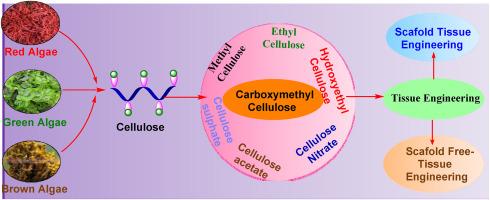Seaweed-derived etherified carboxymethyl cellulose for sustainable tissue engineering
IF 2.4
3区 化学
Q3 BIOCHEMISTRY & MOLECULAR BIOLOGY
引用次数: 0
Abstract
Biodegradability, biocompatibility, abundant supply from renewable sources, and affordability are the outstanding properties of cellulose that have prompted substantial studies into its potential in biomedical applications. Beyond terrestrial sources of cellulose, seaweeds have attracted much attention as a potential source of cellulose because they are widely available. Cellulose and its byproducts may be extracted from various macroalgae species, including red, green, and brown algae. The extracted cellulose's qualities vary depending on the algae species, age, and extraction process utilized. Cellulose's characteristics are enhanced through chemical modifications, specifically etherification and esterification, which substitute functional groups for hydroxyl groups, yielding a range of products, including cellulose acetate (CA), cellulose nitrate, cellulose sulfate, methylcellulose, and carboxymethyl cellulose (CMC). The ability to modify CMC characteristics for particular applications is explored through techniques including grafting processes mixing, and cross-linking with other polymers. Moreover, tissue engineering is given significant consideration in the growing use of CMC and its altered forms in biological applications. These alterations allow for the production of scaffolds that promote tissue regeneration and cell proliferation, enabling CMC-based scaffolds for various tissue engineering uses. This review provides a comprehensive overview of CMC's properties, modifications, and potential in tissue engineering.

用于可持续组织工程的海藻衍生醚化羧甲基纤维素。
纤维素具有生物可降解性、生物相容性、可再生资源供应丰富以及价格低廉等突出特性,这些特性促使人们对其在生物医学应用方面的潜力进行了大量研究。除了陆地纤维素来源之外,海藻作为纤维素的潜在来源也备受关注,因为它们可以广泛获取。纤维素及其副产品可从各种大型藻类(包括红藻、绿藻和褐藻)中提取。提取的纤维素质量因藻类种类、年龄和提取工艺的不同而异。纤维素的特性可通过化学修饰得到增强,特别是通过醚化和酯化,用官能团取代羟基,产生一系列产品,包括醋酸纤维素(CA)、硝酸纤维素、硫酸纤维素、甲基纤维素和羧甲基纤维素(CMC)。通过接枝工艺、混合工艺以及与其他聚合物交联等技术,我们探索了改变 CMC 特性以满足特定应用的能力。此外,在生物应用中越来越多地使用 CMC 及其改变形式,组织工程也是其中重要的考虑因素。这些改变可以生产出促进组织再生和细胞增殖的支架,使基于 CMC 的支架能够用于各种组织工程。本综述全面概述了 CMC 的特性、改性以及在组织工程中的应用潜力。
本文章由计算机程序翻译,如有差异,请以英文原文为准。
求助全文
约1分钟内获得全文
求助全文
来源期刊

Carbohydrate Research
化学-生化与分子生物学
CiteScore
5.00
自引率
3.20%
发文量
183
审稿时长
3.6 weeks
期刊介绍:
Carbohydrate Research publishes reports of original research in the following areas of carbohydrate science: action of enzymes, analytical chemistry, biochemistry (biosynthesis, degradation, structural and functional biochemistry, conformation, molecular recognition, enzyme mechanisms, carbohydrate-processing enzymes, including glycosidases and glycosyltransferases), chemical synthesis, isolation of natural products, physicochemical studies, reactions and their mechanisms, the study of structures and stereochemistry, and technological aspects.
Papers on polysaccharides should have a "molecular" component; that is a paper on new or modified polysaccharides should include structural information and characterization in addition to the usual studies of rheological properties and the like. A paper on a new, naturally occurring polysaccharide should include structural information, defining monosaccharide components and linkage sequence.
Papers devoted wholly or partly to X-ray crystallographic studies, or to computational aspects (molecular mechanics or molecular orbital calculations, simulations via molecular dynamics), will be considered if they meet certain criteria. For computational papers the requirements are that the methods used be specified in sufficient detail to permit replication of the results, and that the conclusions be shown to have relevance to experimental observations - the authors'' own data or data from the literature. Specific directions for the presentation of X-ray data are given below under Results and "discussion".
 求助内容:
求助内容: 应助结果提醒方式:
应助结果提醒方式:


